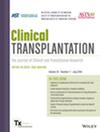Urinary Complications and Long-Term Graft Survival After Primary Atypical Ureteral Anastomosis in Live-Donor Kidney Transplantation
Abstract
Objectives
To assess the urological complications and long-term renal graft survival after primary atypical ureteral anastomosis (PAUA) and to compare it to the standard ureteral anastomosis technique.
Material and Methods
This is a retrospective analysis of all transplant patients with PAUA between 1976 and 2019. The primary outcome was to compare early (urinary leakage and ureteral obstruction) and delayed urinary complications (ureteral stricture and stones), and febrile UTI to the outcomes using the standard ureteral anastomosis technique (control). The second outcome was to compare the long-term graft function and graft survival between the groups.
Results
PAUA was performed in 73 patients, including 39, 27, and 7 patients with ureteroureterostomy, ureteral anastomosis to an augmented bladder, and an ileal conduit, respectively. The control group included 2961 patients. PAUA had a statistically significant higher incidence of urinary leakage (9.6% vs. 2.4%, p = 0.002), ureteral stricture (4.1% vs. 1.2%, p = 0.03), and febrile UTI (28.8% vs. 4.2%, p < 0.001), with insignificant differences regarding early ureteral obstruction (p = 0.6) and stone disease (p = 0.1). At last follow-up, no statistically significant differences in median serum creatinine or e GFR (p = 0.1) were identified between both groups. The cumulative 1-, 2-, 3-, 5-, and 10-year graft survival were 94% versus 94%, 89% versus 92%, 85% versus 89%, 74% versus 82%, and 53% versus 60% in studied group and control, respectively (HR: 0.9, 95% CI = 0.6–1.2, p = 0.6).
Conclusion
Although kidney transplant patients with PAUA have significantly a higher urinary complication rate than those with a standard ureteral anastomosis technique, they have a comparable cumulative graft survival.
Summary
Primary atypical anastomosis of the kidney transplant ureter into an augmented bladder, native ureter, or ileal loop conduit is associated with higher incidence of urinary leakage, ureteral stricture, and febrile urinary tract infection. However, it has no significant impact on long term graft survival.

 求助内容:
求助内容: 应助结果提醒方式:
应助结果提醒方式:


